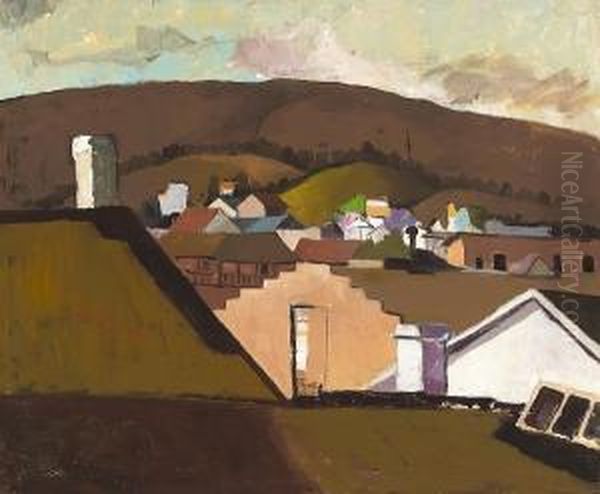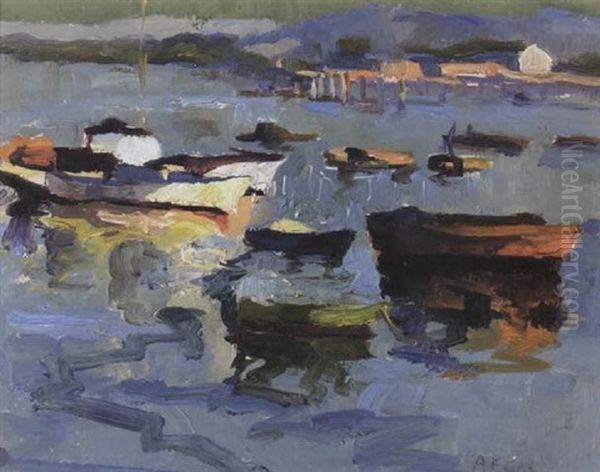August François Pierre Gay, a name synonymous with the vibrant modern art movement in early 20th-century California, stands as a testament to intuitive artistry and a profound connection to the landscape. Born on June 12, 1890, in Rabun, France, Gay's journey would take him across the Atlantic to become a pivotal figure in the development of a distinctly Californian mode of expression, most notably as a core member of the influential "Society of Six." His life, though relatively short, was marked by an unwavering dedication to his artistic vision, even amidst economic hardship, leaving behind a legacy of works that continue to captivate with their bold coloration and dynamic compositions.
Early Life and Artistic Awakening
August Gay's formative years were spent in France, but around the age of eleven, in 1901, he immigrated to the United States with his family. They initially settled in Alameda, California, a move that would prove crucial in shaping his artistic path. The Californian environment, with its unique light and diverse landscapes, undoubtedly began to seep into his consciousness from an early age. His formal artistic training commenced at the prestigious California School of Fine Arts (CSFA) in San Francisco, now known as the San Francisco Art Institute. This institution was a hub of artistic activity, and Gay would have been exposed to various prevailing styles and influential instructors.
Following his studies at CSFA, Gay further honed his skills at the California College of Arts and Crafts (CCAC) in Oakland, from which he graduated in 1918. During these educational years, he would have encountered the lingering influence of Tonalism, championed by artists like Gottardo Piazzoni and Xavier Martinez, and the burgeoning popularity of Impressionism as adapted by Californian painters. However, Gay and his close associates were already looking towards more radical European developments, particularly the Fauvist movement.
The Society of Six: A Brotherhood of Modernists

The most significant chapter in August Gay's artistic career is inextricably linked with the "Society of Six." This group, formed around 1917 and active primarily through the 1920s, was a collective of like-minded painters based in the Oakland area who shared a passion for modern art, particularly the expressive use of color inspired by French Fauvism. The members included Selden Connor Gile, Maurice Logan, William H. Clapp, Bernard von Eichman, Louis Siegriest, and August Gay himself. They were often dubbed the "Oakland Six."
Selden Gile was, in many ways, the charismatic and intellectual center of the group. His home often served as their meeting place, where they would discuss art, critique each other's work, and share meals. The Six were committed to plein air painting, venturing into the East Bay hills, the Oakland waterfront, and the surrounding countryside to capture the essence of the Californian landscape directly. Their approach was a departure from the more subdued palettes of earlier California Impressionists; they embraced bright, often unblended colors, bold brushwork, and simplified forms, seeking to convey emotional responses to their subjects rather than mere visual accuracy.
The Society of Six held their first significant group exhibition at the Oakland Art Gallery (now the Oakland Museum of California) in 1923, an event that announced their arrival as a potent force in the regional art scene. Their work, while shocking to some conservative viewers, was championed by figures like William H. Clapp, who became the director of the Oakland Art Gallery in 1918 and provided crucial support and exhibition opportunities for the group. The influence of European modernists like Henri Matisse, André Derain, and Maurice de Vlaminck was evident in their canvases, yet the Six forged a style that was uniquely their own, deeply rooted in the Californian experience.
Gay's Distinctive Artistic Voice
Within the Society of Six, August Gay developed a distinctive artistic voice. While sharing the group's enthusiasm for vibrant color and expressive form, his work often possessed a particular sensitivity and a unique structural quality. He was known for his intuitive understanding of color relationships and his ability to translate the ruggedness and brilliance of the California landscape into powerful visual statements. Unlike many of his contemporaries who had received extensive European training, Gay's approach was described as more instinctual, allowing him to create works of startling originality.

His paintings often featured strong compositional elements, with forms defined by bold outlines and planes of flat, intense color. He was less concerned with meticulous detail and more focused on capturing the overall mood and character of a scene. Whether depicting rolling hills, coastal views, or urban landscapes, Gay's work exuded a sense of energy and immediacy. He was a master of simplifying complex scenes into their essential components, allowing the interplay of color and shape to carry the expressive weight of the painting.
The camaraderie within the Society of Six was vital. They frequently painted together, learning from one another and pushing each other's artistic boundaries. This collaborative spirit, combined with their shared commitment to modern artistic principles, fostered an environment of rapid growth and experimentation. Artists like Clayton S. Price, though not a formal member, also associated with the group and shared some of their stylistic tendencies, further enriching the artistic dialogue of the era.
Representative Works: Capturing the Californian Essence
August Gay's oeuvre is rich with depictions of the Californian landscape, particularly the areas around Monterey and Carmel, where he later settled. One of his notable works, "Ranch in Carmel Valley," exemplifies his approach. In this painting, Gay uses broad strokes of vibrant color to depict the sun-drenched hills and rustic structures of the valley. The simplification of forms and the emphasis on color harmonies create a powerful sense of place, conveying the heat and rugged beauty of the region.
Another significant piece is "View of Old Monterey from the Rooftops of Stevenson House." This oil painting, typically sized around 20 x 24 inches, showcases his ability to transform an ordinary view into an extraordinary composition. From a high vantage point, Gay captures the historic architecture of Monterey, using bold, Fauvist-inspired colors to define the buildings and the surrounding landscape. The interplay of light and shadow, rendered through contrasting hues, adds depth and dynamism to the scene. The work reflects not only his mastery of color but also his keen eye for composition, leading the viewer's eye through the scene with a carefully constructed arrangement of shapes.
Other works, such as "Monterey Cypress" or paintings of fishing boats and coastal scenes around Monterey Bay, further demonstrate his affinity for the region. These pieces often feature the characteristic gnarled cypress trees, the bustling activity of the wharves, or the serene expanse of the Pacific, all rendered with his signature bold palette and expressive brushwork. He was adept at capturing the unique atmospheric conditions of the California coast, from the bright clarity of a sunny day to the more muted tones of a foggy morning.
His paintings stand in contrast to the more romantic or academic styles prevalent at the time, aligning him with other pioneering California modernists like E. Charlton Fortune, who also worked extensively in the Monterey area, and Armin Hansen, known for his powerful depictions of maritime life. While their styles differed, they all contributed to a growing sense of a distinct West Coast artistic identity.
Later Years and Shift in Focus
The Great Depression brought significant economic challenges for many artists, and August Gay was no exception. The art market contracted, and opportunities for painters became scarce. During the last decade of his life, from roughly 1939 until his death, Gay increasingly turned his creative energies towards furniture design and woodworking. He established a workshop in Carmel, where he crafted custom furniture, often with a rustic, handcrafted aesthetic that complemented the artistic and bohemian spirit of the community.
This shift does not necessarily indicate an abandonment of his painterly ideals but rather a practical adaptation to changing circumstances. The same eye for form, proportion, and material that informed his paintings likely found expression in his furniture designs. It's a testament to his versatile creativity that he could transition between these different artistic mediums. Despite this change in primary occupation, his reputation as a significant painter, particularly for his contributions during the Society of Six era, remained.
August Gay passed away in Carmel, California, on March 9, 1949. His death marked the end of a life dedicated to art, a life that saw him contribute significantly to the modernist movement on the West Coast.
Legacy and Enduring Influence
August Gay's legacy is primarily tied to his involvement with the Society of Six and his role in introducing and popularizing a modern, color-centric approach to landscape painting in California. The Society of Six, as a collective, played a crucial role in challenging the established academic traditions and paving the way for subsequent generations of modern artists in the region. Their bold use of color and expressive techniques were revolutionary for their time and place.
While perhaps not as widely known nationally as some of his East Coast contemporaries or even other California artists like Maynard Dixon or Guy Rose, Gay's work has been increasingly recognized for its quality and historical importance. Exhibitions focusing on the Society of Six and California modernism have brought renewed attention to his contributions. His paintings are held in various public and private collections, valued for their vibrant energy and their authentic depiction of the California scene.
Art historians now recognize August Gay as a key figure in the early California modernist movement. His intuitive approach to color, his strong compositional sense, and his commitment to capturing the essence of his environment place him among the important innovators of his generation. He, along with his fellow members of the Society of Six, helped to define a regional response to international modernism, creating a body of work that remains fresh, vigorous, and deeply connected to the spirit of California. His influence can be seen in the continued tradition of expressive landscape painting in the state.
The story of August Gay is one of artistic integrity and a passionate engagement with the visual world. From his early training to his pivotal role in the Society of Six and his later work as a craftsman, Gay consistently demonstrated a deep understanding of form, color, and composition. His paintings serve as a vibrant record of California in the early 20th century and as a lasting testament to the power of an artist who dared to see and depict the world in a new and exciting light, leaving an indelible mark on the art history of the American West. His work continues to inspire and engage viewers, securing his place as a significant, if sometimes underappreciated, master of California modernism.